Draw a Box Around Each Knot
How to draw Celtic knotwork 3 – REPEATS Brand INTERLACE
Happy then far? :-)
This 3rd page on how to depict Celtic knotwork depends on your first knowing nearly crossed cords as the bones unit of measurement and also how to join cords to cease off a knot.
At present for how to make your Celtic knot literally as long as a slice of string.
The unproblematic crossed-cords-in-a-foursquare unit repeats very easily to create long twists, plaits or sections of interlace. Here's the basic two-crossed-cords-in-a-square unit of measurement again:
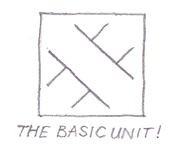
And here is the same, basic unit of the Celtic knot joined up with another, identical unit of measurement placed alongside it:
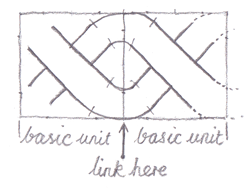
Notice that when you lot are repeating units like this, y'all don't need to add any extra space in between in gild to join cords (unlike the ends of knots). You only 'scoop' the line round and information technology joins up. (Joining cords to stop off the ends of knots is covered in more detail dorsum in the second page of the tutorial.)
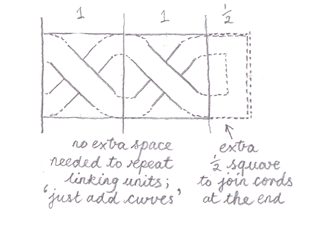
And so here is the beginning piece of Celtic decoration that can exist made. Information technology'due south the bones unit joined with several others to create the simplest possible version of a plait – a ii-strand twist:
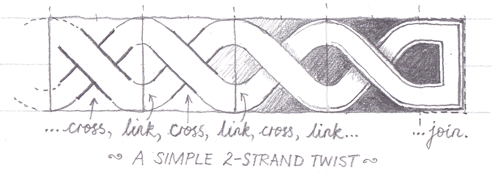
It's pretty enough and information technology makes a nice border; and information technology's used in the original Celtic manuscripts to fill narrow, pointed spaces, as in this example from the Canterbury Codex Aureus:

But information technology doesn't look much ... a bit like watching someone juggling ii balls. And it gives the impression you could just unravel it with a flick of the wrist.
Nevertheless, this two-cord twist is a vital pace on the style to learning how to depict Celtic knotwork of far greater scope and ambition.
You can meet that some of the same rules utilise for repeating a pattern that we saw in joining cord-ends. It helps if you don't describe the original crossed cords too close to the edges of the square they sit in. That way, you can draw smooth curves to join the cords, without kinks or irregularities.
Doubling up a 2-strand twist
So far, y'all may feel that we have twisted lots of bits of string into nothing very impressive in terms of how to draw Celtic knotwork. Just what happens if nosotros repeat the same uncomplicated crossed-cords unitupwardly as well as along?
What y'all're doing here is running another twist along the top of the one y'all've already got. Then, you're just extending the lines of the bottom row of crossed cords so that they encounter upward with -- and become -- cords in the acme row.
At the edges, cords plow back into the plait again. In the middle, cords keep going in straight lines if they possibly tin.
Like this:
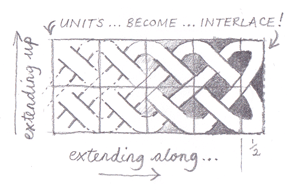
Past golly, it'south a 4-strand plait! – a department of woven border! Why, that's almost all you demand to know about how to draw Celtic knotwork!
If you don't observe that exciting … well, fine.
To be serious: this is also the time to notice onevery important signal which applies towhatever 'how to depict Celtic knotwork' method:
What goes overmust go under; what goes undermust become over.
A cord which has crossed over the top of another cordmust gonether the next string information technology encounters, and vice versa. It'south a strict rule for interlace patterns.
Remember you drew your original two-crossed-cords-in-a-square equally right-handed crosses? Now where your cords join upwardly they must form left-handed crosses staggered in between the original right-handed crosses. Over and under, over and under is the unvarying rule.
Take another look:
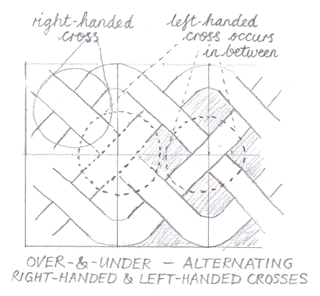
So, whenever you find yourself wondering how to draw Celtic knotwork, apply the following rules.
If crossed cords are correct-handed in the center of a square, they are left-handed where four squares meet upwards (and vice versa, if they're left-handed in the eye of a square, they're right-handed where the corners of the squares meet).
Another way of looking at information technology is that if the cords cross correct-handed along the edge of a plait or pattern, they'll cantankerous left-handed 'up a level and along 1', and they'll cross right-handed once again on top of that.
If you oasis't already done so, now'south the fourth dimension for you to demonstrate how to draw Celtic knotwork ... well, interlace, anyway.
Outset, draw half dozen squares in a block of three by two:
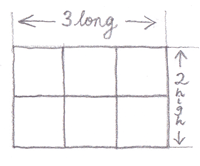
Add 2 half-squares down the left-hand and right-hand edges, in which to bring together up the ends:
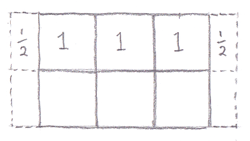
Then draw six right-handed crossed cords, i in each box, remembering non to go right to the edges. (If y'all're not sure of this chemical element of Celtic drawing, encounter the [earlier] tutorial page):
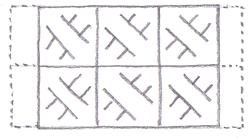
And so draw the left-handed crossed cords that go in between, on summit of the places where the square boxes meet up:
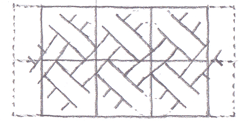
So bring together up all the ends along the edges past drawing smoothen curves betwixt the outside lines and then smaller curves between the inside line. This element of Celtic drawing governs the final 'flow' of the knot. Go along the cord-width abiding:
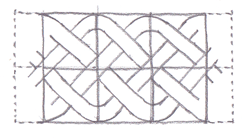
And so bring together up the ends in the half-squares. The meridian cord in the summit row joins the top cord in the bottom row; the bottom string in the top row joins the lesser string in the bottom row. Similar this:
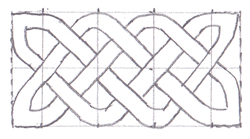
Bank check your cords are all going over-and-nether-and-over-and-under. If not, check the before steps for where the drawing went wrong, and right information technology, or showtime over again.
If all'south well, colour in the niggling spaces between the cords, and rub out whatsoever construction lines (the lines of the original squares):
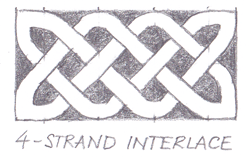
Congratulations. You have (I hope) just produced a piece of genuine Celtic cartoon. It's not quite patterned knotwork yet, but it'southward very close indeed, and information technology's authentic Celtic ornamentation.
In that location's one important folio left -- on how to describe more interesting Celtic knotwork patterns by introducing breaks into the weaving.
wrefordequaidell85.blogspot.com
Source: https://www.calligraphy-skills.com/how-to-draw-celtic-knotwork.html